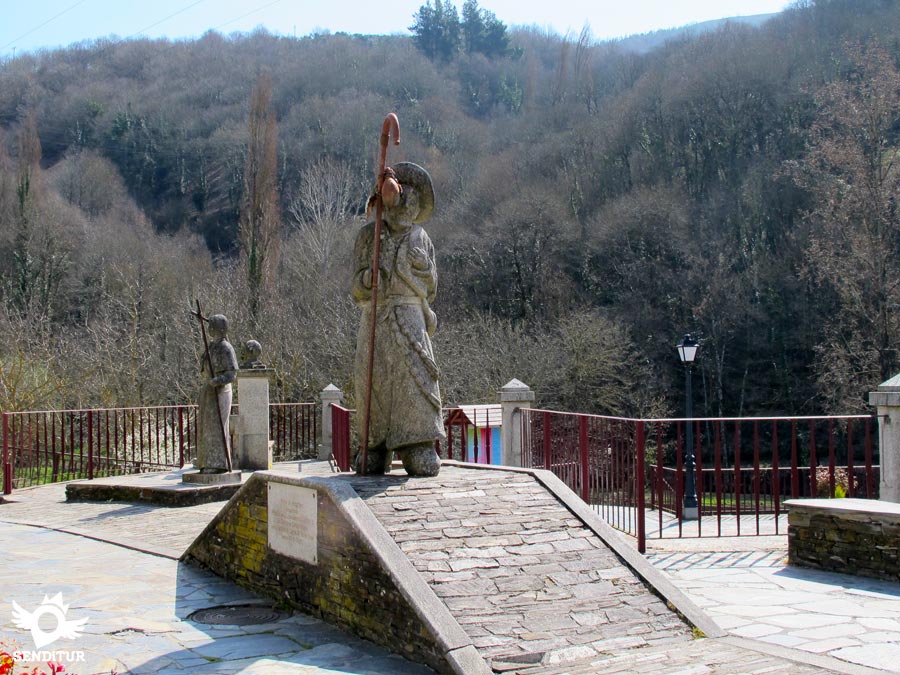It is located in a valley in the foothills of the eastern Galician mountains, in a beautiful natural environment. Its council is made up of a good number of parishes which in turn group together so many other villages, some of them located right on the Way of Saint James such as San Cristovo Do Real, Renche, Lastres, Freituxe, San Martiño do Real, Foxos, Teiguin, Pascais, Gorolfe and Sivil, that are crossed of going by the variant that routes its steps, crossing Penapartida, towards Samos and its abbey, or in the other alternative, that without stepping on Samos, passes by San Xil, Montan, Fontearcuda and Furela, belonging to the concello of Samos and wrapped by forested valleys. Although the history of Samos is closely linked to that of its monastery, it is known that there were prehistoric settlements in the area, as witnessed by the abundant castros, dating back to the long period of time that goes from the 7th century BC to the 2nd century AD, although they very possibly lasted until the Middle Ages. But the oldest trace of these primitive settlers can be found in the caves of Santalla. With the foundation of the monastery back in the 6th century, the evolution of the people of Samos was in line with that of the monks, suffering together the ups and downs of the wars and enjoying the privileges and bonanzas granted to them by the kings, nobles and bishops who passed through here.

In Samos is a must visit the Monastery of San Julián and Santa Basilisa, and very close to him a small Mozarabic construction with a spectacular tree attracts attention remembering the beginnings of the monastery, as it is said that it was a cell of the monastery of Samos, is the chapel of Cypress also known as the chapel of the Savior. In the village, the Clock Tower, the municipal box or the public fountain are also proudly displayed. In addition, the Oribio River on its banks offers pleasant walks and small parks where you can enjoy nature. In the surroundings of Samos, the Lóuzara valley or the Sierra de Oribio are the delight of daring adventurers and hikers, as paragliding or caving are guaranteed, as well as beautiful routes discovering the area. The villages of its council also have their special interest and attractiveness, San Cristovo do Real has a beautiful Galician popular architecture. Renche y Lastres, whose parish church, named in the year 1175 in a papal bull as adhered to the monastery of Samos, keeps in its interior a Santiago pilgrim. Freituxe, San Martiño do Real, with a church that is Romanesque rura. Foxos or Teiguin and Pascais whose parish church, which preserves the apse from its Romanesque structure, is known to have been given to the monastery of Samos in 1098. Gorolfe with its chapel of Nuestra Señora de los Milagros. Sivil, San Xil or Montan whose parish church is of Romanesque origin and is dedicated to Santa María. Fontearcuda which belongs to the parish of San Martiño de Lousada, or Furela, which proudly displays a house with a shield and the chapel of San Roque. Any corner of the municipality can surprise the visitor with an admirable landscape or with a rural typicalism that joins in its past and present constructions. We must not forget that Samos is crossed by the Oribio river, a small river with an abundance of eels and trout that have become one of the typical gastronomic dishes of the area.

Samos celebrates San Benito on July 11 and on January 9 celebrates Santa Basilisa who is patron saint of the monastery.
In Samos are traditional sponge cakes Manjarín, sweet that was originally made in the kitchen of the monastery more than 250 years ago.
In the parish of San Cristovo do Real is located the Pazo de Lusío that was founded by Lope Vázquez de Vilamexe in the year 1551 and belonging to this pazo the remains of an old forge remind us that it forged the railings of the cathedral of Lugo.

The chapel of the Cypress, rather the millenary tree that guards it, keeps its own legend that says that the abbot Virila sitting under his shadow questioning himself about eternity was absorbed listening to a little bird sing, remaining in this state more than three hundred years. At the time the chapel was built, in the 10th century, it was customary to plant one cypress at a time and by its side, as a sign of spiritual place.
Samos can be reached via the LU-633 road that joins Pedrafita do Cebreiro, on the A-6, with Sarria, partly following the route of the Way of Saint James. Also the LU-P-5601 and 5602 are in charge of communicating Samos with the neighboring localities.
Samos has a bus service that connects it with Piedrafita do Cebreiro, Sarria and Lugo from Monday to Saturday. The nearest bus station is in Sarria.
Samos
San Cristovo do Real
Renche
Lastres
Freituxe
San Martiño do Real
Foxos
Teiguín
Pascais
Gorolfe
Sivil
San Xil
Montán
Fontearcuda
Furela
SENDITUR is not responsible for any variation in the information described, as well as for the misuse of its guides and recommends that everyone be responsible and prudent in carrying out the activity. Likewise, we invite you to document yourself with books and specialized guides to complement the information described. From the commitment of SENDITUR with Nature and the respect to the balance of the environment, SENDITUR urges you to travel in a responsible way, with low environmental impact and respecting at all times the Natural, Cultural and Social environment wherever you go. For any suggestion, SENDITUR invites you to send an email to
Continue watching …